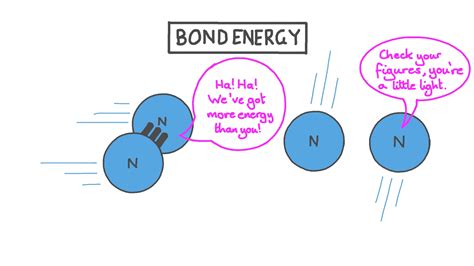In chemistry, bond energy refers to the amount of energy required to break a chemical bond. It is a crucial concept that helps us understand the stability and reactivity of molecules. Understanding changes in bond energy can provide valuable insights into various chemical processes.

Factors Affecting Bond Energy
Several factors can influence bond energy, including:
- Bond Type: Single bonds are weaker than double bonds, which are weaker than triple bonds.
- Bond Length: Shorter bonds are generally stronger than longer bonds.
- Electronegativity: The difference in electronegativity between the bonded atoms affects bond strength.
- Resonance: Compounds with resonance structures have lower bond energies due to the delocalization of electrons.
Measuring Changes in Bond Energy
Changes in bond energy can be measured using various techniques, such as:
- Calorimetry: Measures the heat released or absorbed during a chemical reaction involving bond breaking or formation.
- Spectroscopy: Analyzes the absorption or emission of light by molecules to determine bond energies.
Applications of Understanding Changes in Bond Energy
Understanding changes in bond energy has numerous applications in chemistry, including:
- Predicting Reactivity: Predicting the reactivity of molecules based on their bond strengths. Stronger bonds are less reactive, while weaker bonds are more reactive.
- Designing New Materials: Designing new materials with specific properties by manipulating bond energies. For instance, stronger bonds lead to more durable materials.
- Understanding Biological Processes: Elucidating the mechanisms of biological processes, such as enzyme catalysis and protein folding, which involve changes in bond energies.
Table 1: Typical Bond Energies (kJ/mol)
| Bond Type | Bond Energy |
|---|---|
| C-H | 413 |
| C-C | 347 |
| C-O | 358 |
| C-N | 305 |
| O-H | 464 |
| N-H | 391 |
Table 2: Factors Affecting Bond Energy
| Factor | Effect on Bond Energy |
|---|---|
| Bond Type | Single bond < Double bond < Triple bond |
| Bond Length | Shorter bond > Longer bond |
| Electronegativity | Greater difference in electronegativity > Lower difference in electronegativity |
| Resonance | Resonance structures > No resonance structures |
Table 3: Applications of Understanding Changes in Bond Energy
| Application | Description |
|---|---|
| Predicting Reactivity | Determine the reactivity of molecules based on their bond strengths. |
| Designing New Materials | Manipulate bond energies to design materials with specific properties. |
| Understanding Biological Processes | Elucidate the mechanisms of biological processes involving changes in bond energies. |
Table 4: Strategies to Manipulate Bond Energy
| Strategy | Effect on Bond Energy |
|---|---|
| Adjust Bond Length | Shortening or lengthening the bond |
| Control Electronegativity | Matching electronegative atoms or introducing electronegative groups |
| Induce Resonance | Introducing resonance structures to delocalize electrons |
| Use Catalytic Processes | Utilize catalysts to lower the activation energy for bond breaking or formation |
Conclusion
Changes in bond energy are a fundamental concept in chemistry. Understanding these changes allows us to predict reactivity, design new materials, and elucidate biological processes. By manipulating bond energies, we can potentially develop novel applications and technologies.
